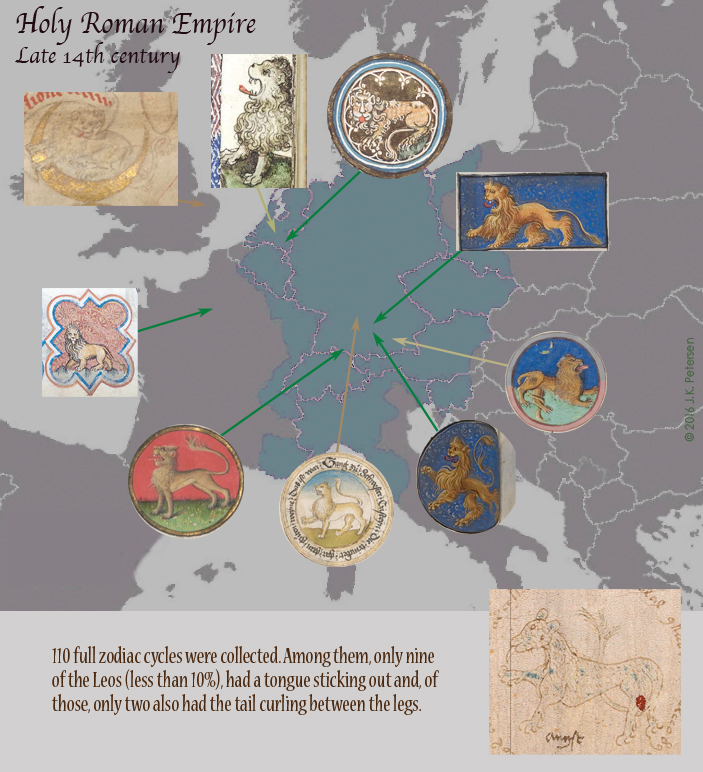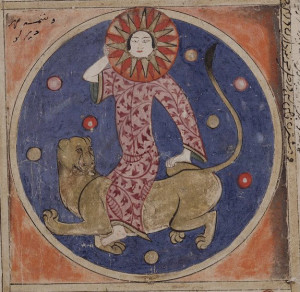The Tip of the Tongue
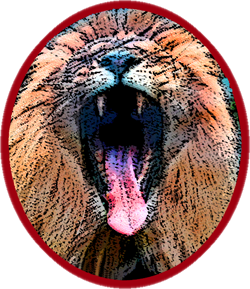 When I saw the VMS Leo symbol with its tongue sticking out, it reminded me of a South Pacific tongue dancer I saw when I was a teenager. He was dressed in colorful native attire, with tattoos and face paint, a spear in his hand, and looked amazingly fierce when he came over to where we were sitting on the ground and showed the whites of his eyes and displayed his tongue.
When I saw the VMS Leo symbol with its tongue sticking out, it reminded me of a South Pacific tongue dancer I saw when I was a teenager. He was dressed in colorful native attire, with tattoos and face paint, a spear in his hand, and looked amazingly fierce when he came over to where we were sitting on the ground and showed the whites of his eyes and displayed his tongue.
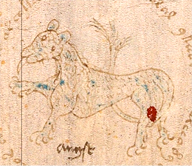 The VMS lion isn’t as fierce looking as the tongue dancer, but the image made me curious about how many other zodiac Leos had their tongues sticking out. After scouring the digital manuscript archives and collecting more than 100 medieval zodiac cycles, I only found nine with protruding tongues, and only two of those had their tails curled between their legs. Another thing I noticed with all the Leos except one or two from the Mediterranean region, is that they had full manes.
The VMS lion isn’t as fierce looking as the tongue dancer, but the image made me curious about how many other zodiac Leos had their tongues sticking out. After scouring the digital manuscript archives and collecting more than 100 medieval zodiac cycles, I only found nine with protruding tongues, and only two of those had their tails curled between their legs. Another thing I noticed with all the Leos except one or two from the Mediterranean region, is that they had full manes.
None of the tongue-Leos had a tree in the background, either, so it seems the VMS Leo is unique in a number of ways. You can see the zodiac Leos I found with tongues in the following map, superimposed on political boundaries for the late 14th century.
The tongue Leos were mostly from central Europe with a few in France, the Netherlands, and eastern England.
It’s not even certain whether the VMS symbol is a lion. Sometimes spotted cats such as cheetahs are substituted for lions as zodiac symbols, but these are not common, either. The VMS Leo diverges from tradition and the tree in the background looks like it might be a palm tree rather than a deciduous tree, entirely appropriate if you consider lions are mostly concentrated in hot countries.
It’s possible the VMS lion was inspired by zodiac illustrations of lions from the Mediterranean, which sometimes don’t have manes. There are also non-zodiac lions that have their tails curled through their legs, but whether the VMS illustrator based the drawing of Leo on having seen a lion in real life, or from studying a Mediterranean manuscript, is difficult to determine.
Since the VMS Leo resembles north-central European Leos in other ways, maybe the illustrator simply chose to draw a lion without a mane, just as he or she chose to draw a pair of crayfish (instead of a single one) as a cancer symbol, something I have yet to see in any other zodiac. Resemblance doesn’t always guarantee that a drawing was imitated.
The maned lions we think of as African lions used to inhabit southern Europe but were crowded out by hunting and loss of habitat between the time Stonehenge was built and about a century BCE except for a few that remained in the Caucasus until the 11th century. Cave lions, which looked more like the American mountain lion, were extinct long before the African lion disappeared from Europe.
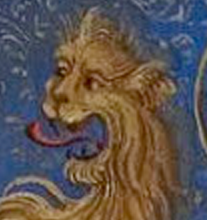 We know that the VMS illustrator was exposed to zodiac traditions in books or perhaps on the floors and walls of cathedrals or temples, but we don’t know if the way the symbols are drawn is based on other zodiacs or on illustrations and carvings of animals and mythical heroes not directly connected with a zodiac cycle.
We know that the VMS illustrator was exposed to zodiac traditions in books or perhaps on the floors and walls of cathedrals or temples, but we don’t know if the way the symbols are drawn is based on other zodiacs or on illustrations and carvings of animals and mythical heroes not directly connected with a zodiac cycle.
Many western zodiacs, in the north and the south, included labors of the month, and sometimes those labors included animals like goats, sheep, and others, so they too might have inspired an inventive person to create zodiac symbols that were mostly like others but also different in some unique ways.
J.K. Petersen
© Copyright 2016 J.K. Petersen, All Rights Reserved

